As a merchant or an eCommerce owner, you want the best for your website. You want a fast site that provides a great user experience and better performance. But which frontend framework solution is right for you – Magento’s Luma, Hyvä Themes, or PWA? In this blog post, we’ll compare Luma, Hyvä, and PWA to make the decision process easier.

Panda Group’s experiences with Magento development
At Panda Group for 10 years already, Magento development has been an integral part of our work. With Magento’s transition from Magento 1 to Magento 2, and Magento’s new focus on headless solutions with Progressive Web Applications (PWA) versus traditional monolith themes like Luma and Hyvä, we have embraced the challenge of keeping up with the ever-evolving Magento landscape.
Our experience in Magento development has enabled us to guide our clients toward the best Magento frontend solutions. This knowledge helps them to run reliable, secure Magento websites that meet their needs and lead to success.
How to choose the right Magento front for your needs?
There are some basic questions to be considered regarding your individual situation during the decision-making process. Pre-implementation analysis consists of some starting points issues to identify your business needs and adjust an appropriate solution. By asking yourself the following questions you can make sure you choose the Magento front-end solution that best meets your needs.
Is Magento 1 to Magento 2 migration needed?
If you are a Magento practitioner evaluating Magento 1 or Magento 2 for your eCommerce business, different front-end solutions are applicable in both situations and Magento 1 to Magento 2 upgrade might be necessary for some circumstances.
Panda Group Magento Development Agency’s experts explore the best Magento frontend solutions in various individual situations. You might expect in-depth analysis and consultancy to learn the different options’ pros and cons in your individual business context.
Is monolith or headless a better option?
You have two paths you can go for the Magento frontend solution. The first one is a monolith with dedicated Magento default frontend Luma or its outstanding modern alternative Hyvä Themes. Monolith’s alternative can be headless with PWAs (Progressive Web Application) technology.
PWA technology is a powerful solution, but it is also more complex and has different technical requirements. You fiirst need to evaluate if your eCommerce store project needs PWA or if the Magento monolith would be enough.
What are your eCommerce scale and future growth perspective?
Making the right Magento new frontend choice depends on a number of factors, such as: how many products and transactions are involved.
What are the technical complexity and future scalability perspective of the system?
Do your profit growth predictions justify more advanced technology solutions and investments?
What are your time-to-market expectations?
As more complex solutions are usually more time and budget-consuming these are fundamental questions that need to be asked before concluding the decision-making process.
Is a mobile-first eCommerce approach a must?
If you are running the business successfully, you know exactly if a mobile-first approach is needed. Maybe you already have a mobile app handling the situation well enough?
It is important to remember that the website’s mobile version should be optimized and ready to work on any device.
It can also be a good idea to consider alternative options if you don’t have an app yet, such as PWA, which enables more flexibility when running mobile commerce and also improves Google’s performance.
Are you satisfied with your site’s User Experience and performance?
UX and website performance are crucial questions in the highly competitive eCommerce industry. Some Magento frontend solutions provide advanced features that guarantee high speed, smooth user experience, and flawless performance.
Frontend redesign is a great opportunity for UX audit, which can improve the shopping experience, client satisfaction, and your business results.
One of our recent projects can be presented in the following steps:
- Profound UX audit.
- Magento 1 to Magento 2 Migration.
- Frontend redesign with Hyvä Themes according to the UX audit.
The result was 90% desktop performance and 300% on-site events increase in the first couple of weeks.
Please find the details in the following Case Study – Hyvä Themes and Magento frontend redesign.
The goal here was to improve poor performance and UX. Our recommendation was to use Hyvä Theme. In order to do it, the upgrade from Magento 1 to Magento 2 was needed.
Better performing Magento frontend than Luma Theme
Performance can be one of the most important factors in deciding which Magento front is right for your eCommerce business. Magento dedicated frontend Luma is not satisfactory for most of the users who started to implement other options.
PWA has been one of them since 2015 and Hyvä is another valuable option since 2021. We have noticed that PWA-based solutions and Hyvä frontend perform much better, especially on mobile devices, and UX metrics than traditional Luma-based themes.
Depending on the eCommerce individual situation we can recommend:
- Magento monolith with Hyvä Frontend,
- Magento headless which can be accompanied by PWA technology.
What is the Magento ecosystem?
Magento eCommerce is an all-inclusive platform that provides merchants with the tools they need to manage their online stores and maximize their sales. The Magento ecosystem offers complete flexibility in eCommerce opportunities and comes with a host of integration capabilities, enabling businesses to join forces and offer customers more resources, such as customer support or inventory tracking.
Magento eCommerce also includes a variety of tools such as analytics, search engine optimization (SEO) options, payment gateways, and social media integration. Magento’s comprehensive technology helps retailers quickly create website designs tailored to individual customer needs while providing businesses full control over content and catalog management.
Magento’s powerful technological platform makes it easy for businesses to scale up over time – making Magento the perfect choice for any engagement level in eCommerce platforms.
Magento as a monolith eCommerce system
Magento eCommerce is an innovative monolith solution for businesses that need an all-in-one solution for their webstore. This platform enables businesses of any size to manage their entire website from a single, manageable software solution that integrates seamlessly with Magento’s vast suite of tools and services.
Magento’s monolithic framework makes it easy to create a cohesive online presence and adds flexibility to customize your store’s look, feel, and functionality. With Magento, you can easily add new products, manage orders, track customer activity, and more, while giving you the added benefit of scalability – allowing you to expand your reach within your target market. Magento is the perfect option for businesses seeking an intuitive and reliable eCommerce system coupled with powerful storefront capabilities.
Luma Theme default Magento frontend
Magento’s popular Luma theme has long been a flagship of Magento eCommerce, but its ability to keep pace with ever-shifting technology changes and user preferences is now limited. The outdated tech stack tends to result in poor loading times and frontend performance, not to mention generally lackluster customer experience.
Fortunately, Magento developers now have access to robust frontend solutions specifically designed by Magento Community members for a better Magento experience that offers store owners the ability to deliver an effective, visually appealing storefront while achieving superior frontend performance improvements over Luma.
Hyvä Themes as a Luma frontend alternative
Hyvä Theme is an innovative and modern Magento eCommerce monolith frontend framework that brings much-needed new life to the outdated tech stack of Luma. Its minimalistic design, user-friendly interface, and scalability are giving Magento merchants fresh and robust options for their online store.
It’s truly a revolutionary replacement for Luma, allowing Magento users to upgrade their sites quickly and seamlessly with powerful tools tailored perfectly to their needs. With Hyvä, Magento users can experience the future of Magento with ease directly from within their dashboard.
For more detailed information on Hyvä Theme please check our blog post explaining the Hyvä technology and why it’s a good solution for Small and Medium businesses – Hyvä Themes makes Magento friendly for SME e-commerce.
Hyvä Themes vs Luma UX and Performance
As was said above, UX and site performance are crucial when composing the technology stack, especially for the eCommerce industry.
Comparing Hyvä and Luma in terms of Google Core Web Vitals metrics is a useful method to evaluate the user experience of Magento eCommerce monoliths.
These metrics provide key insights into the performance and weight of pages, which play a huge role in their SERP listing position. It’s beneficial to make sure that your Magento store continues to offer the best possible UX for customers, so monitoring and optimizing these CWV metrics is important for ensuring customer satisfaction and success in Google metrics.
Hyvä Core Web Vitals’ outstanding results
Below you can compare the Core Web Vitals compliance of Hyvä and the traditional Magento monolith.
Over 50% of Hyva pages reach the Google UX requirement while only 20% of regular Magento Pages are compliant with Google CWV.
Hyvä regularly scores above the 90th percentile in all three Core Web Vitals metrics, proving it is an effective and reliable solution for eCommerce merchants.
When it comes to speed, Hyvä loads twice faster as its Luma counterpart and is 3x lightweight making it the clear choice when considering a scalable and responsive Magento frontend.
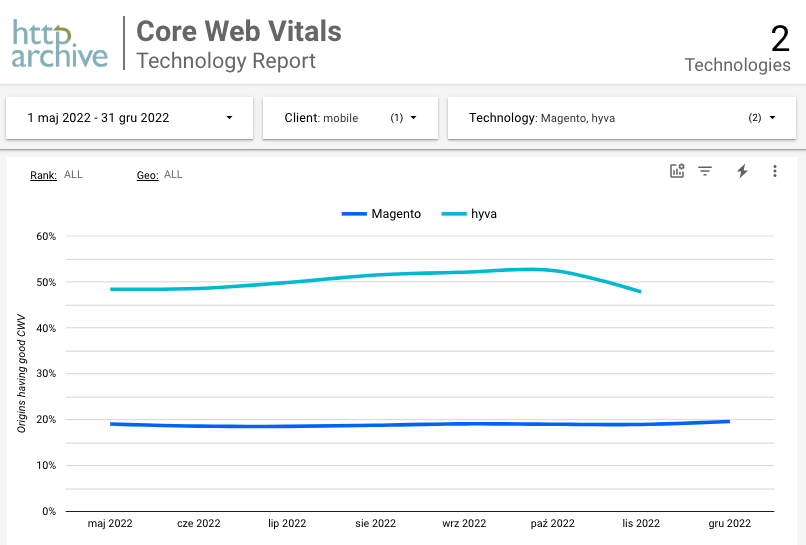
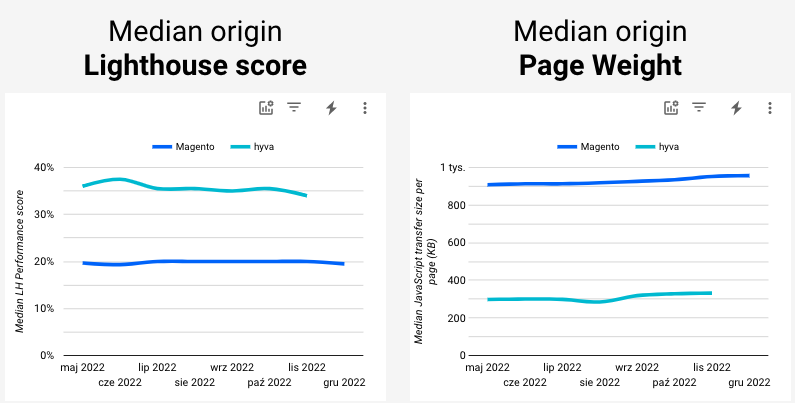
Magento 2 performance optimization with Hyvä
Core Web Vitals compliance requires Magento with Luma performance optimization and this is quite a complex process as a matter of fact. It needs to be repeated and done all over again to keep up with Google standards.
Just the opposite you can expect from Hyvä – it is Core Web Vitals compliant and great performing with no burdens unless it is not laden with excessive code. It is very important to follow Hyvä documentation and instructions to keep the highest standards.
Access our Ebook and discover how Hyvä can help you make your site perform better, have an improved UX, and stay ahead of the curve with permanent improvements to Core Web Vitals metrics.
Our toolbox provides vital insights for increasing speed, creating interactivity, and visual stability – so get ready to boost the performance!
Magento headless solution
The monolithic architecture supports your e-commerce platform by keeping the front and back ends tightly intertwined – a powerful combination to handle any task.

On the other hand, headless commerce solutions take a different approach: they utilize APIs to allow the frontend and backend of your store to operate independently while still working together harmoniously.
For more information on headless eCommerce, please check our blog article on Headless Magento eCommerce development.
Headless CMS architecture offers the flexibility to deliver consistent content across multiple platforms. It is designed with an eye towards long-term functionality, supporting not only web pages and mobile devices but also emerging technologies such as smartwatches and beyond. The PWA (Progressive Web Apps) technology is one of the solutions here to connect your eCommerce with mobile devices.
PWA solutions for headless Magento eCommerce
If you want to deliver your customers the same user experience on mobile devices as on desktop you may need to develop additional applications with a similar user interface.
PWA is basically a hybrid of native mobile applications and web pages. It provides an excellent user experience with fast loading time and offline access to content. PWAs native apps are great for eCommerce stores as they allow customers to browse, add products to their cart, and checkout without any problems even if a device isn’t connected to the internet at all.
You can choose from several possibilities for a PWA storefront:
- Adobe PWA Studio
- Scandi PWA
- Vue Storefront
PWA (Progressive Web App) Magento eCommerce was increasingly gaining attention in previous years due to its ability to create an enhanced shopping experience for customers.
Whether you are looking for a powerful development platform or a quicker way of getting your business online, PWA provides you with several options. From Adobe PWA Studio to Scandi PWA, and Storefront PWA — there are many possibilities available to you for creating a PWA eCommerce website.
Each platform possesses its own set of advantages and capabilities that could be beneficial depending on the size and scope of your project. To make the right decision please consult your needs and possible solutions with experts working with PWA technology on a daily basis.
At Panda Group we have experience with all the above-mentioned solutions. Do not hesitate if you have any questions about them. You can be sure our Magento developers will share their knowledge with you.
Hyvä vs PWA (Magento PWA Studio) UX and Performance
To do the comparison on the same basis as the above Hyvä Theme and PWA you need to have a look at Core Web Vitals compliance, performance, and page weight. Hyvä takes advantage over PWA Studio and PWA in all these dimensions.
With Core Web Vitals, it gets closer to PWA but stays high above PWA Studio. In performance, loading speed again is closer to PWA in general but PWA Studio is not even close. Finally, when it comes to the page weight which is vital in the all-over performance score PWA Studio is again highly above Hyvä and closer to PWA’s other solutions.
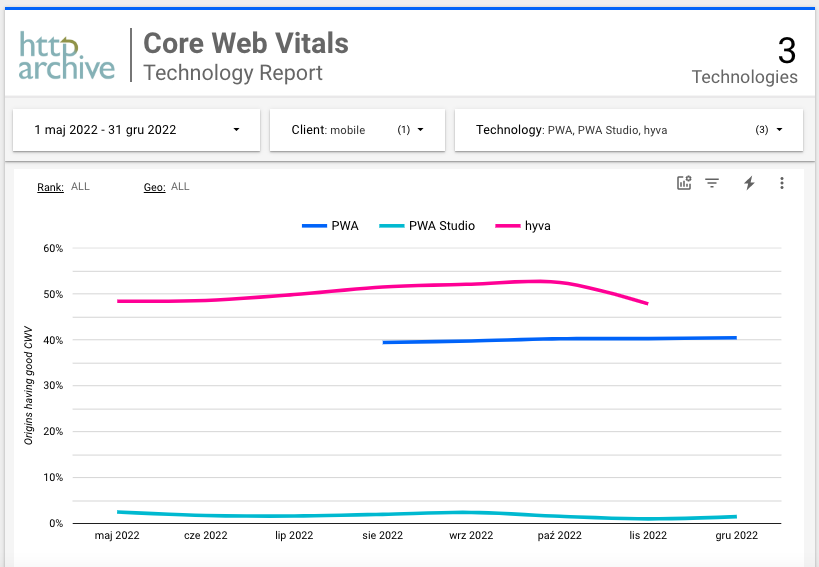
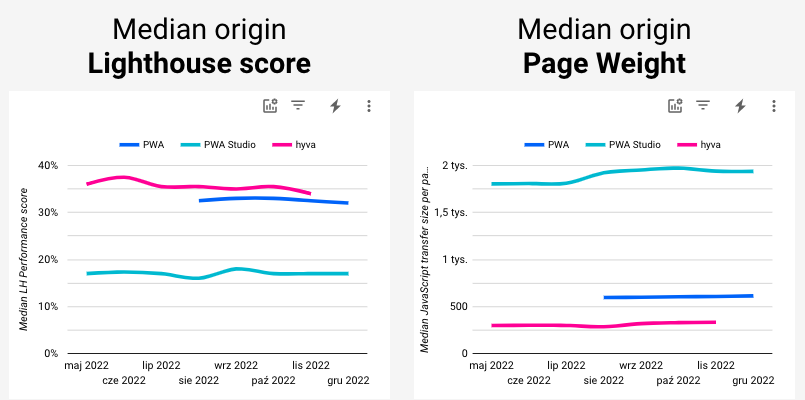
Hyvä Theme tech stack
It is also worth considering that Hyvä is based on PHP, exactly like Magento, which makes it similar to the Magento framework. Hyvä Themes simply is a new version of traditional themes.
The Hyvä Community derives from Magento Community and they use basically the same tools. Thus,the learning curve for developers is low because of the similarities.
The advantage of Hyvä over traditional themes is its lightweight and simplicity allowing for a faster and cheaper development process. Simplicity is appreciated by developers also, as it helps to accomplish projects faster and with better performance than before to satisfy business needs.
PWA technology
PWA (Progressive Web Application) is a totally different technology and an emerging new way to take eCommerce to the next level. PWA support for Magento 2.4 and higher offers a streamlined package of benefits for customers, such as faster page loading times, access to content with no need for an app installation, and more reliable usage in areas with low internet connectivity.
Furthermore, PWA technology enables high-end features like push notifications, geolocation data, secure payment processing, and more. With PWA integration, businesses can provide a nearly native-like experience that often requires fewer resources than building a full-fledged iOS or Android app.
PWA is transforming the digital customer experience – allowing merchants to offer a truly optimized browsing experience that will increase conversions and improve customer satisfaction overall.
Time to market and cost of Hyvä and PWA
As PWA is a much more complex solution – it also requires more time to market and budget than Hyvä. We hardly work on just PWA or Hyvä implementation, they are usually a part of larger projects as was explained in the Case Study above.
To estimate the time needed for developing PWA is 4-6 months while for Hyvä it would be 2-4 months for a simple project.
More time for development means additional costs, and the Hyvä license price is 1000 EUR. Nevertheless, PWA implementations as a part of headless eCommerce are much more complex and require twice or sometimes 3 times more budget than Hyvä.
This is the main reason we recommend Hyvä as a Magento monolith for SME eCommerce while headless is rather an option for the fastest growing enterprises, the market leaders, and innovation setters.
Conclusion
At Panda Group we very much consider the individual eCommerce situation to compose a tailored tech stack that is suitable for the business condition. We do not intend to develop a framework that is excessive to the needs just because it is hype or on the other hand that is not enough in the short and long-term scalability perspective.
After 10 years of Magento eCommerce development, we really understand the eCommerce business and keep the effects in our minds all the time while the project is being developed.
You can count on a frank diagnosis and consultancy throughout the project duration. Let’s talk to check what we can do for you!


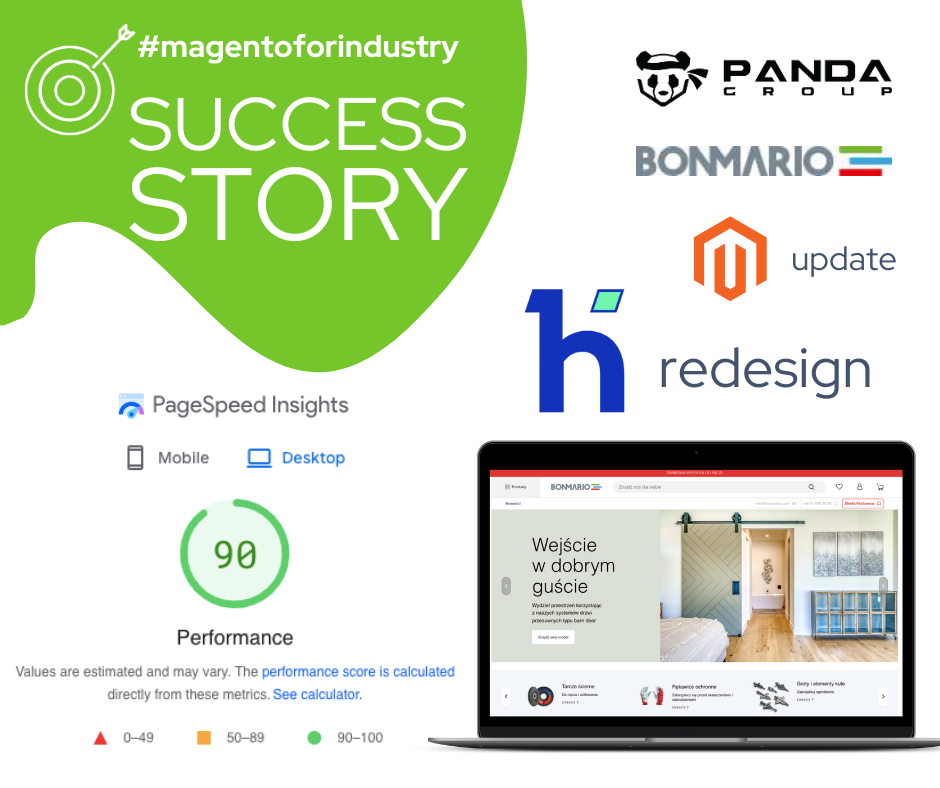

 (No Ratings Yet)
(No Ratings Yet)